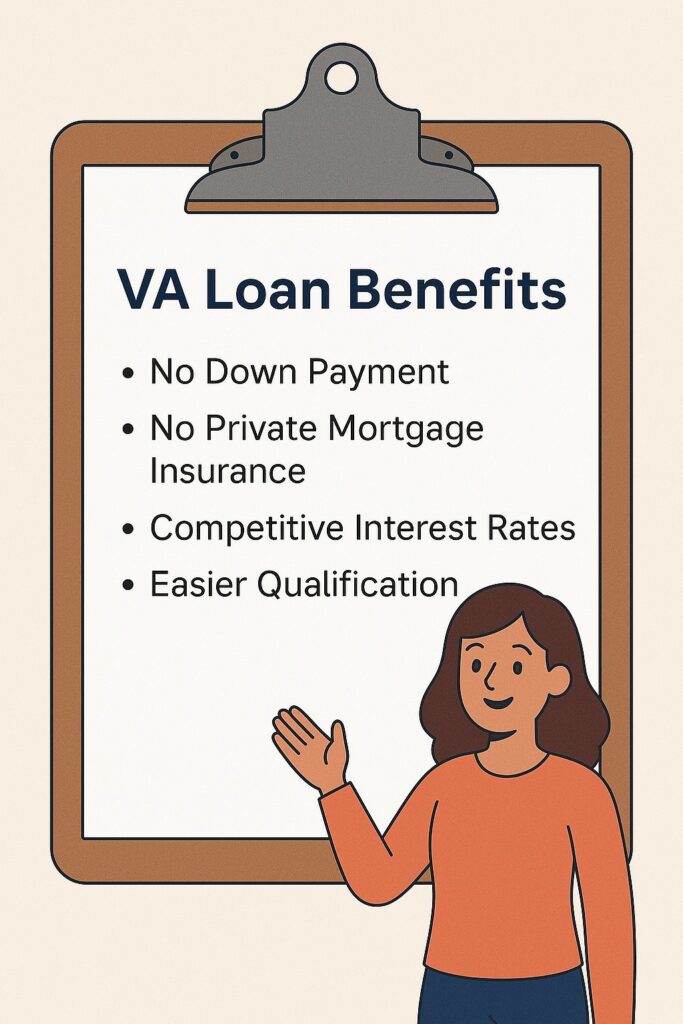If you’re a veteran or active-duty service member considering buying a home, understanding VA loan requirements is your first step to unlocking affordable homeownership. This guide covers eligibility, benefits, costs, calculators, and comparisons to conventional loans, giving you all the information you need to make a smart decision.
VA Loan Requirements: Who Qualifies?
The VA loan requirements are straightforward but essential to understand:
- 90 consecutive days of active wartime service or 181 days in peacetime;
- 6 years in the National Guard or Selected Reserve;
- Spouse of a service member who died in the line of duty or from service-connected causes.
Besides military service, lenders also assess your credit, income stability, and debt-to-income ratio before issuing pre‑approval, which strengthens your offer in today’s competitive market.
Benefits: Why Choose a VA Loan?
The VA loan benefits make this mortgage type one of the most valuable financial tools available to service members:
- No down payment required (in most cases);
- No private mortgage insurance (PMI);
- Lower veterans mortgage rates compared to conventional loans;
- Restricted closing costs to protect the borrower.
These advantages help make the veteran home loan an appealing and accessible option for military families.

VA Loan vs. Conventional Loan: What’s the Difference?
Choosing between a VA loan and a conventional mortgage requires careful consideration. Here’s a clear comparison:
| Feature | VA Loan | Conventional Loan |
| Down Payment | 0% (in most cases) | 3%–20% required |
| PMI | Not required | Required if <20% down |
| Current mortgage rates | Typically lower | Usually higher |
| Appraisal | VA-mandated | Standard |
| Funding Fee | Required (unless exempt) | None |
| Property Use | Primary residence only | Primary, vacation, or rental |
Downsides:
While beneficial, VA loans have limitations:
- Must be for a primary residence only—no rentals or investment properties;
- Closing costs include a funding fee, from 1.25–3.3% of the loan amount;
- VA appraisals can be stricter, potentially extending the timeline.
Calculator: Estimate Your Costs Accurately
To project your monthly payment—including closing costs, taxes, and insurance—you can use calculators offered by these reliable institutions:
These calculators help estimate costs and compare offers effectively.
Interest Rates: What to Expect
In 2025, VA home loan interest rates remain competitive. When shopping for rates, be sure to check:
These reputable lenders frequently offer updated rate information on their websites.
Refinancing Options: When to Consider It
Already own a VA mortgage? A refinance loan—like the Interest Rate Reduction Refinance Loan (IRRRL)—could help you save. Compare home loan refinance options using calculators and lender tools before making a decision.
Practical Next Steps
Ready to take action on your veteran home loan? Follow this plan:

- Check Your Eligibility — Confirm you meet requirements.
- Compare Lenders — Research current mortgage rates from trusted sources listed above.
- Calculate Your Payments — Use a loan calculator to estimate monthly costs.
- Get Pre‑Approved — Apply for loan pre‑approval with your selected lender.
- Prepare for Closing — Budget for the funding fee and ensure the home meets VA standards.
- Consider Refinancing Later — Explore VA home loan refinance options to reduce future costs.
Conclusion: Is a VA Loan the Right Choice for You?
The VA loan benefits—from no down payment to lower rates—offer strong advantages. However, possible downsides like funding fees and stricter property requirements mean you should compare them carefully against conventional loans. Use calculators, research rates, and follow the steps above to make the right choice.




